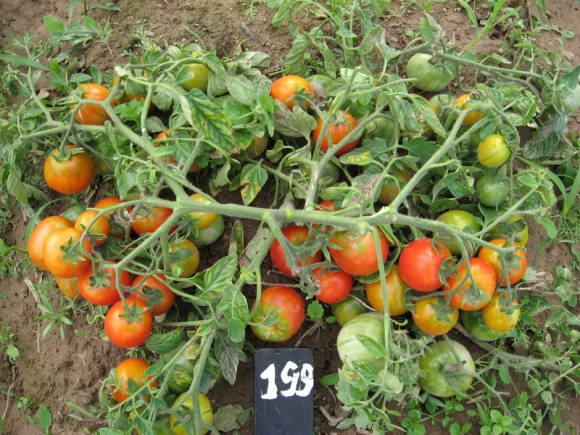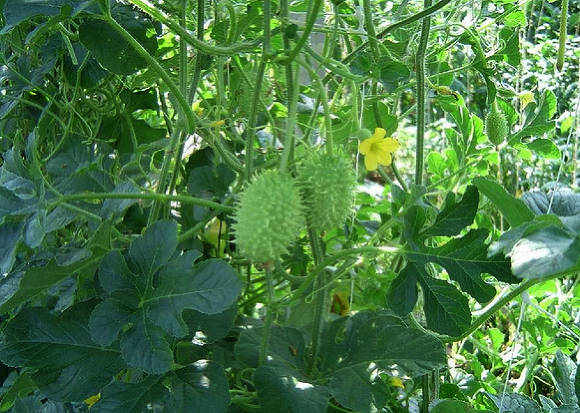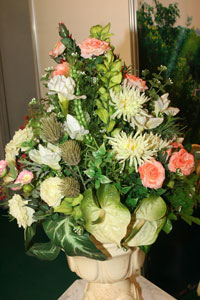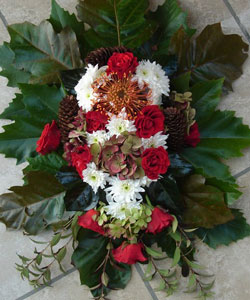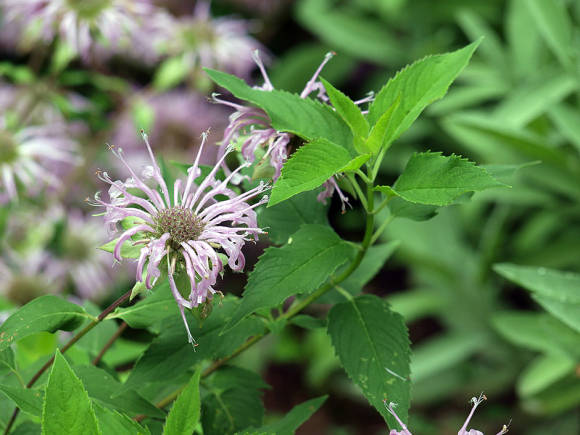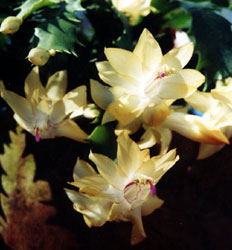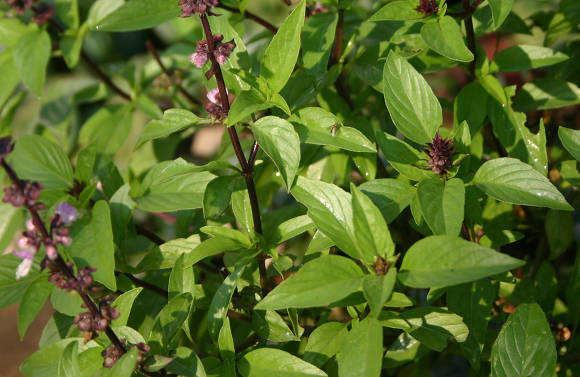Dendrobium noble, or nobile (Dendrobium nobile) originally from the tropical countries of South Asia, in nature it leads an epiphytic lifestyle. Refers to sympodial orchids, which, after the end of the growth of the mother plant, form daughter shoots at the base, thereby continuing the life of the plant. The roots are white, tough. The stem is straight, forms cylindrical pseudobulbs, linear or lanceolate leaves are arranged alternately. In the axils of the leaves, flower buds develop, containing from one to several beautiful "waxy" flowers, often with a pleasant aroma. Each shoot lives for 2-4 years, then dies off.
 |  |
This is one of the finest orchids. Long stems are densely covered with fragrant flowers, from pure white to dark lilac, yellow and even orange in color, there are varieties with tricolor petals. Basically, the varieties are of hybrid origin, but they appear most often under the name D. noble. For any holiday, an elegant dendrobium will successfully replace a bouquet of cut flowers.
 |  |
Dendrobium noble is grown for sale using stimulants. After the purchase, he can please several times with his wonderful flowering at home, even without creating certain conditions. However, for successful cultivation, it is necessary to provide it with coolness in the autumn-winter period and very bright light throughout the year. Without observing the seasonality to which this orchid has adapted in nature, it will soon degenerate, stop blooming, young growths will come out underdeveloped and the plant will die. Ideal conditions are easiest to create in a private house or on a loggia.
Annual cycle of noble dendrobium... Flowering occurs in winter and occurs only after a dormant period. With its end, vegetative growth begins, young shoots grow from the base of the pseudobulb, roots begin to grow (spring-summer). By autumn, the shoots finish their development and the formation of pseudobulbs begins. After that (in the fall), a period of rest should begin, which ends with the appearance of flower buds on pseudobulbs.
 |  |
Conditions of detention strictly depend on the stage of plant development and have a certain periodicity, imitating the seasonality in natural conditions.
Lighting... Dendrobium is a very light-loving orchid. It should be placed only on windows with a southern orientation (southeast, south, southwest), additional lighting may be required on the east or west windows. North-facing windows are not suitable for successful dendrobium cultivation. It is advisable to keep dendrobium outdoors in the warm season (when night temperatures are above + 7 ° C), protecting it only from direct midday sunlight. Immediately after purchase or after home maintenance, dendrobium is not adapted to the sun, and it is necessary to accustom it to the sun's rays gradually so that burns do not appear. It is easy to navigate by the color of the leaves - normally, with sufficient light, they are green. The dark green color of the foliage indicates that the plant receives little light, and yellow indicates an acute shortage of it. If the plant stands in bright light, then the leaves acquire a light green color, then the plant should be slightly shaded from the sun.
Watering should be abundant while the dendrobium is actively growing. This orchid lives on trees with free roots, which at the same time dry out rather quickly and do not tolerate prolonged dampness. Therefore, the soil between waterings should dry out properly. Water the dendrobium by immersing the pot with roots in water for a few minutes.
After the young shoots finish their growth, and small vertical leaves appear at the ends of the young shoots, watering and feeding completely stop, and resume only with the formation of flower buds.Earlier watering will lead to the growth of vegetative buds and daughter shoots will develop on the stem instead of flowers.

Top dressing... Dendrobium is fed with special fertilizers for orchids only during the growing season (from the beginning of flowering to the end of the growth of young shoots), the first and last dressings should be done in half doses.
Temperature... In summer, during active growth, dendrobium prefers a moderate temperature - it is optimal that it is + 25 ° C during the day and + 20 ° C at night. Temperatures above + 30 ° C cause growth arrest.
In autumn, with the end of growth, coolness should come with a large amplitude of daily temperature fluctuations (about 10 degrees). Optimally during the day +15 ... + 20оС, at night +5 ... + 10оС. With a decrease in temperature and in the presence of large daily fluctuations, it is necessary at the same time to provide the dendrobium with very intense light (in the garden or on the balcony in the sun) and stop watering. Only these conditions will lead to bookmark flower buds... Once the flower buds appear, the plant can be moved to a warmer but still cooler room to extend the flowering period. In this case, the light should remain very bright. You should not change the orientation of the pot relative to the light source to avoid dropping the buds.
Air humidity... Since the successful maintenance of dendrobium is possible only in cool rooms in winter and outdoors in summer, it does not need to artificially increase the humidity of the air. Spraying is used only in the summer heat.
Soil and transplant. Choose a healthy plant, then the transplant will not take 2-3 years. Like all orchids, dendrobium does not like frequent transplants, they should be done only if necessary, when the roots are sore, the pot becomes cramped or the substrate has decomposed to a state of rot, threatening the health of the roots. For transplanting, you need to take a pot 2-3 cm wider than the previous one, it should not be transparent. As a substrate, the bark of spruce species of the middle fraction is suitable, the addition of sphagnum and charcoal is permissible. When growing, the curtain can be divided, but in each division there should be no less than three pseudobulbs. Only very old pseudobulbs should be removed.

Reproduction dendrobium at home is possible only by vegetative methods - by dividing the curtain and germinating children from old pseudobulbs removed during transplantation. The first method was described above in the section "Soil and replanting". The second method consists in cutting old shoots into fragments with several internodes and placing them in a greenhouse on wet sphagnum. In bright diffused light and at a temperature of + 20 + 25 ° C, after a few weeks, the formation of daughter shoots in the nodes is possible. When young shoots reach 3-5 cm and have several roots, they are planted one or several in the bark of the fine fraction.
Pests and diseases. Dendrobium is affected by spider mites, mealybugs, scale insects, aphids.
Read more about pest control in the article. Houseplant pests and control measures.
With improper care, the plant is susceptible to fungal diseases, especially when the soil is waterlogged, causing root and stem rot. The plant is difficult to save. An urgent transplant into fresh soil with the removal of rotten roots and pseudobulbs and the treatment of the rest with crushed charcoal or fungicide (Fundazol, Maxim), followed by drying, can help. After transplanting, do not water the plant for 10 days.
Possible problems and frequent questions that arise when growing dendrobium noble
The stems are shriveled... Shrinkage of pseudobulbs is normal for orchids during the growth stage of young shoots. The newly appeared sprouts do not yet have their roots and feed on the mother plant, causing some drying out of the pseudobulbs. Excessive watering at this time cannot help, but will only cause rotting of the roots.In the dry dormant period, shrinking of pseudobulbs is also observed, but it is absolutely impossible to water the plants before the formation of flower buds.
Children grow instead of flowers... To lay flower buds, rest is necessary with the end of the growth of young shoots, when the plant stands in bright light, there are daily temperature fluctuations of about 10 degrees, there is no watering and feeding. Failure to comply with these conditions, too early resumption of watering, is the degeneration of flower buds into vegetative ones.
Dendrobium does not bloom... This happens in the absence or non-strict non-observance of the rest period, or with insufficient lighting.
Leaves fall... Adult stems may lose some of their leaves during or after flowering. Normally, several lower leaves may fall or turn yellow, and the upper ones are most likely associated with a disease.
The pseudobulb has turned yellow or brown. Normally, the pseudobulb may dry out slightly, but retain its green color or become slightly yellowish. Yellow or brown - signs of decay, disease and death.
Thin young shoots... Young shoots begin to gain volume only after the end of growth, then pseudobulbs are formed and the shoots take on a familiar appearance.
Other types of dendrobiums - on the encyclopedia page Dendrobium.
